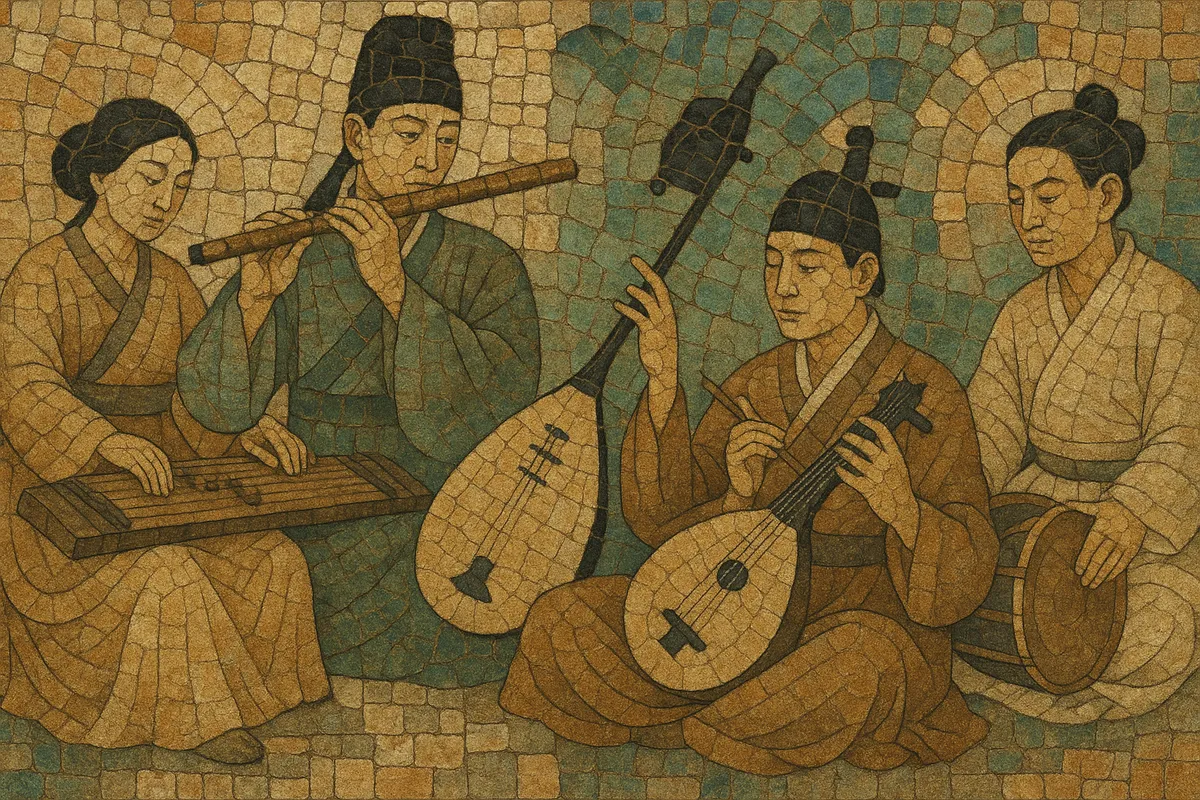Hyangak literally means “native music” and denotes the repertoire of indigenous Korean court and aristocratic music, as distinguished from imported Chinese (dangak) and Confucian ritual (aak) traditions.
It is characterized by stately pacing, spacious phrasing aligned to breath and gesture, and elegant heterophonic textures in which multiple instruments render the same melody with individualized ornamentation.
Typical hyangak ensembles feature the three iconic native strings—geomungo (zither), gayageum (zither), and hyangbipa (pear-shaped lute)—alongside winds such as daegeum (large transverse bamboo flute), piri (double-reed oboe), junggeum and sogeum (smaller flutes), and bowed haegeum, supported by timekeeping percussion like janggu (hourglass drum), buk (barrel drum), bak (clapper), and jwago.
Modal language centers on Korean pentatonic modes (notably pyeongjo and gyemyeonjo), subtle intonation, and ornate sigimsae (ornamentation), yielding a serene yet dignified sound ideal for banquets and ceremonial occasions. The iconic piece “Sujecheon” stands as a hallmark of the style.
The term hyangak (“native music”) emerged in the Goryeo dynasty (918–1392) to distinguish indigenous Korean court/banquet music from imported Tang Chinese banquet music (dangak) and Confucian ritual music (aak). Its roots, however, reach further back to the Three Kingdoms and Unified Silla eras, where aristocratic and ceremonial musical practices developed around native instruments and modal habits.
During Goryeo, hyangak flourished in palace banquets and processions, coexisting with newly imported repertoires. The representative ensemble concept of samhyeon-yukgak (three strings and six winds) became emblematic of court sound. In early Joseon (1392–1897), systematic musical reforms and treatises—culminating in the 15th-century court-theoretical tradition and later the Akhak Gwebeom (1493)—codified instruments, modes, and ensemble roles. Park Yeon and other court scholars standardized pitch, ensemble makeup, and pedagogy, ensuring the continuity of hyangak alongside aak and dangak.
Hyangak privileges measured tempi, breath-shaped phrases, and ornamental nuance (sigimsae). Its modal palette, especially pyeongjo and gyemyeonjo, produces a refined, contemplative ethos suited to royal banquets. The iconic wind ensemble piece “Sujecheon,” derived from earlier poetic and vocal sources, exemplifies hyangak’s transformation of indigenous materials into stately instrumental music. Over time, the broader umbrella term jeongak (“refined music”) came to encompass this courtly sphere, but hyangak retained its identity as the native strand within that tradition.
In the 20th and 21st centuries, national and municipal institutions in Korea have preserved and revitalized hyangak through dedicated court orchestras and research programs. The National Gugak Center and allied ensembles maintain historical instruments, tunings, and performance practice, while creative and fusion gugak draw on hyangak’s modal and textural DNA to craft new works for contemporary stages.


